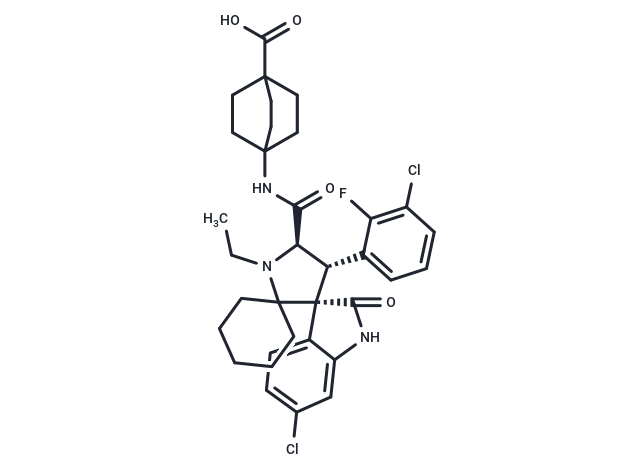Shopping Cart
- Remove All
 Your shopping cart is currently empty
Your shopping cart is currently empty

Alrizomadlin is an orally active MDM2 inhibitor. APG-115 shows significant dose-dependent inhibitory effects on TP53wt AML cell lines. The IC50 values are 26.8 nM for MOLM-13 cells and 165.9 nM for MV-4-11 cells. , OCI-AML-3 cells 315.6 nM. Alrizomadlin blocks the interaction of MDM2 and p53 and induces cell cycle arrest and apoptosis in a p53-dependent manner.

| Pack Size | Price | Availability | Quantity |
|---|---|---|---|
| 1 mg | $263 | In Stock | |
| 5 mg | $619 | In Stock | |
| 10 mg | $888 | In Stock | |
| 25 mg | $1,270 | In Stock | |
| 50 mg | $1,530 | In Stock | |
| 100 mg | $1,990 | In Stock | |
| 1 mL x 10 mM (in DMSO) | $786 | In Stock |
| Description | Alrizomadlin is an orally active MDM2 inhibitor. APG-115 shows significant dose-dependent inhibitory effects on TP53wt AML cell lines. The IC50 values are 26.8 nM for MOLM-13 cells and 165.9 nM for MV-4-11 cells. , OCI-AML-3 cells 315.6 nM. Alrizomadlin blocks the interaction of MDM2 and p53 and induces cell cycle arrest and apoptosis in a p53-dependent manner. |
| Targets&IC50 | MDM2:3.8 nM |
| In vitro | METHODS: CD4 T cells isolated from mouse spleen were exposed to 250 nM APG-115 for 3, 6, and 24 hours, and the effect of APG-115 on T cell viability and activation was investigated. RESULTS APG-115 treatment did not induce apoptosis of CD4+ T cells, but promoted CD4+ T cell activation, as evidenced by an increase in the proportion of CD25highCD62Llow cells and an increase in cell size. In addition, treatment did not lead to an increase in the number of regulatory T cells (Tregs), demonstrating a positive activation effect on effector T cells. [1] METHODS: Different concentrations of APG-115 (0.001-100μM) were used to treat TP53wt AML cell lines, including MOLM-13, MV-4-11, OCI-AML-3, and HL-60 and SKM-1 cells with TP53 mutations or deletions. , the treatment time is 72 hours, and cell viability, cell cycle and apoptosis analysis are detected. RESULTS APG-115 showed significant dose-dependent inhibitory effect on TP53wt AML cell line, with IC50 values of 26.8 nM for MOLM-13 cells, 165.9 nM for MV-4-11 cells, and 315.6 nM for OCI-AML-3 cells; APG -115 treatment caused a significant increase in the proportion of MOLM-13 cell apoptosis, reaching a maximum of 96.8% (1 μM concentration), and caused cell cycle arrest in the G0/G1 phase. [2] |
| In vivo | METHODS: APG-115 was orally administered to TRP53-/- knockout C57BL/6J mice at 10 or 50 mg/kg daily or every other day (Q2D) to observe the effect of APG-115 on tumor growth in mice. RESULTS APG-115 can effectively activate the p53 pathway, affect macrophage polarization (reduce M2 type, increase M1 type), and increase PD-L1 expression on tumor cells, regulate the immune microenvironment, and enhance anti-tumor immune response. [1] METHODS: APG-115 was administered to mice orally (PO), 20 mg/kg, once every two days for 21 days; daily administration: 50 mg/kg, for 7 days; daily administration changes High dose: 100 mg/kg for 7 days to observe the in vivo therapeutic effect of APG-115. RESULTS Administration of APG-115 significantly reduced leukemia burden and prolonged survival in mice in the TP53 wild-type systemic MOLM-13 AML model. Compared with the control group, the median survival time of the APG-115 treatment group was extended by approximately 18.5 days. [2] |
| Alias | AA-115 |
| Molecular Weight | 642.59 |
| Formula | C34H38Cl2FN3O4 |
| Cas No. | 1818393-16-6 |
| Smiles | CCN1[C@H]([C@H](c2cccc(Cl)c2F)[C@]2(C(=O)Nc3cc(Cl)ccc23)C11CCCCC1)C(=O)NC12CCC(CC1)(CC2)C(O)=O |
| Relative Density. | 1.42 g/cm3 (Predicted) |
| Storage | Powder: -20°C for 3 years | In solvent: -80°C for 1 year | Shipping with blue ice. | |||||||||||||||||||||||||||||||||||
| Solubility Information | DMSO: 90 mg/mL (140.1 mM), Sonication is recommended. | |||||||||||||||||||||||||||||||||||
Solution Preparation Table | ||||||||||||||||||||||||||||||||||||
DMSO
| ||||||||||||||||||||||||||||||||||||

Copyright © 2015-2025 TargetMol Chemicals Inc. All Rights Reserved.